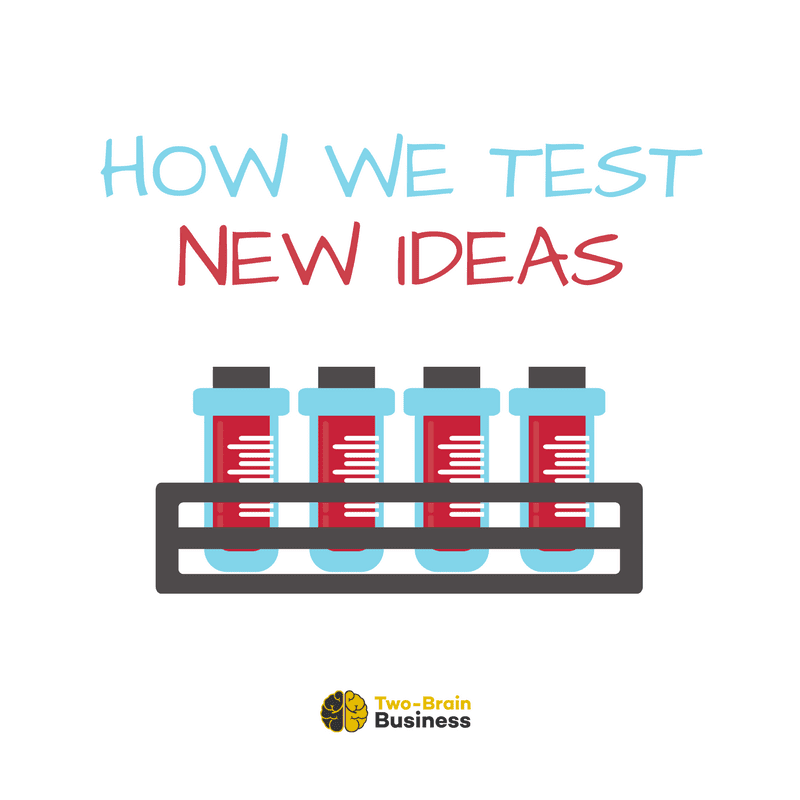An uncaffeinated state is not my favorite. Neither is “hangry”. But I’m at my writing table without coffee or food this morning, because we’re testing an idea at my gym.
Catalyst is often the Petri dish for new ideas. In this case, we’re taking blood from ten clients and coaches, shipping it to a lab for analysis, and then looking at the results together. Those results might mean a better way to make exercise and nutrition prescriptions. On the other hand, they might mean nothing. So we don’t share the idea with other gyms until we’re sure, one way or the other.
Our new COO, Mike Lee, described Two-Brain Business as an “idea machine”. We now have twelve mentors on the team, and each of them is brilliant. That means a huge idea every half-second.
Some of the ideas are great. These are the ones you read about in my books, and on this site. Others don’t work out, and you never hear about them.
Here’s our vetting process:
- A mentor or member of the TwoBrain family has a great idea.
- We ask them to test the idea, and suggest an objective basis for comparison. Instead of, “Did you like it? Did people like it?” we don’t guess: we say, “what results can prove this is better than what you were doing before?” or even “What data says this is better than doing nothing at all?”
- If data supports the new idea, we share it with three other mentors on the team. Some of us–especially Brian Alexander and me–are only too willing to test new ideas, but we try to spread it out. You really can’t test more than one thing at a time, and since we’re always testing, we spread ideas around.
- If data still supports the new idea, we’ll cherrypick ten clients and share our experience with them. Then we’ll tell them exactly what to do, and they’ll test the idea for three months. After three months, we’ll collect their data and ask, “How could this be better?”
- We add the new idea to our curriculum, either in the Incubator or Growth stages. This happens around one time in eight. For new knowledge to replace old, it has to make a SOLID case. In other words, we’re not guessing.
As the most-trusted source of business education in the gym business, it’s our duty to fully test ideas before we say, “This is good.” We know that gym owners are exposed to salesmen and evangelists way too often. For example, when someone says “Wodify is the best, hands down, bar none!” we should ask them, “What else have you tried?”
Healthy skepticism is a necessary part of healthy business.
One of our partners sent me a screen shot on Friday. His title was “The Two-Brain Effect”, and the picture showed dozens of people texting him for help. We’re proud of the trust we’ve earned with you. And we don’t take it lightly.
We take the time to TEST new ideas, because we don’t want to make guesses with your business. Our gyms aren’t fragile, and can handle a few misses. Why make mistakes at yours?
I’ve never met a gym owner who didn’t have at least three great ideas. But that’s part of their problem: they have more ideas than they can possibly act upon, and so they get paralyzed. They’re almost too smart, too creative, too hardworking for their own GOOD. So in the Incubator, we start with a blank slate, and build the infrastructure of their business step by step. Later, in Growth stage, mentors frequently ask, “Which one of these great ideas are we going to work on this quarter?” because trying to do everything usually means achieving nothing.
Today’s experiment will cost me around six thousand dollars. There’s a centrifuge in our Athletic Therapy office, a bunch of ice packs in the staff freezer, and unused needles lined up on the manager’s desk. Blood testing for nutrition prescriptions seems like it could be a great idea, and a potential differentiator for CrossFit gyms (Orange Theory and Billy’s Bootcampz aren’t going anywhere near this; only real coaches will go this deep.) I’m excited to see my results.
But it might NOT work.
It’s my duty to you to be SURE, not just confident.
I want data, not just stories about Games athletes. I want to KNOW, not guess, because what’s at stake–your gym–is too important. Here we go!

